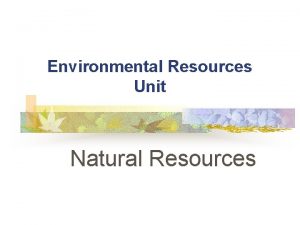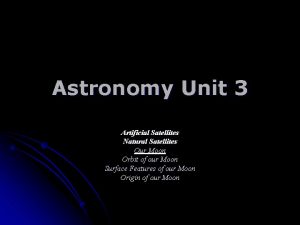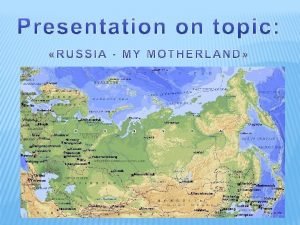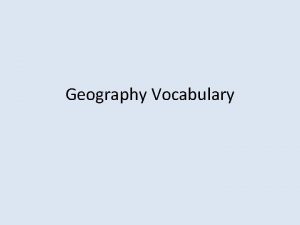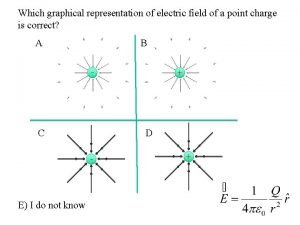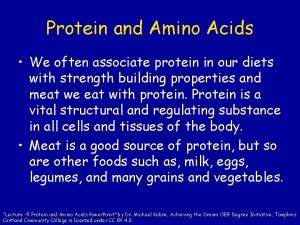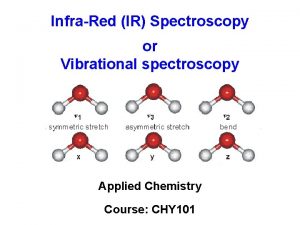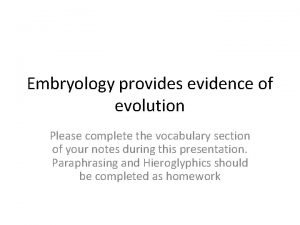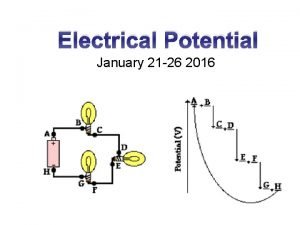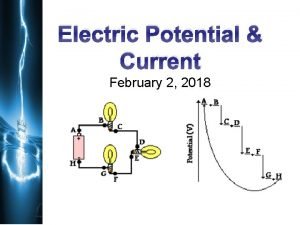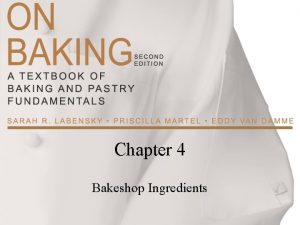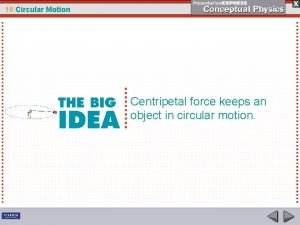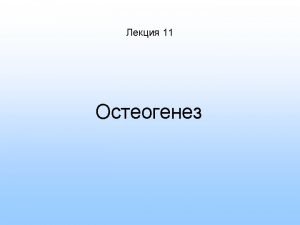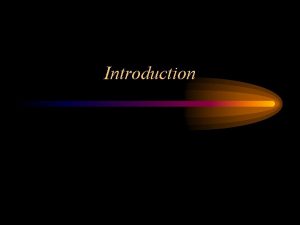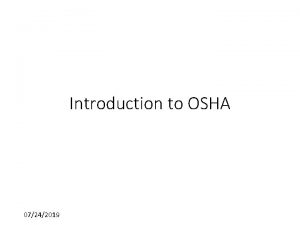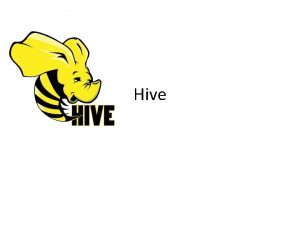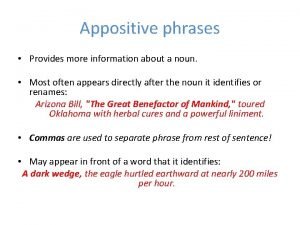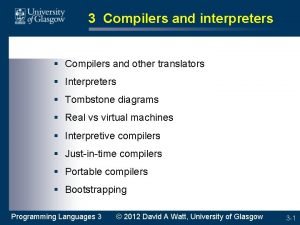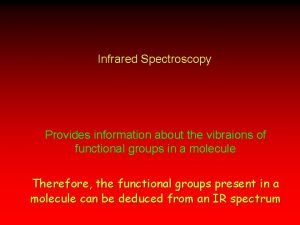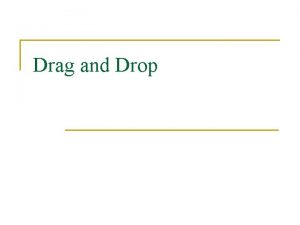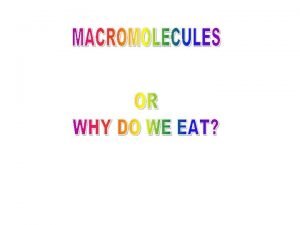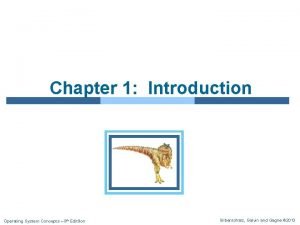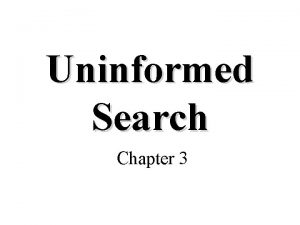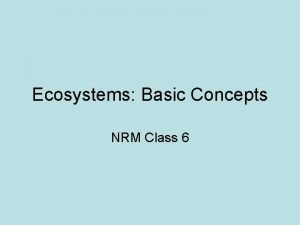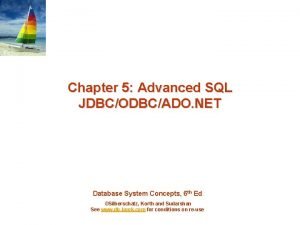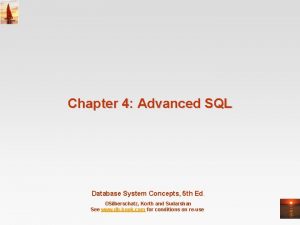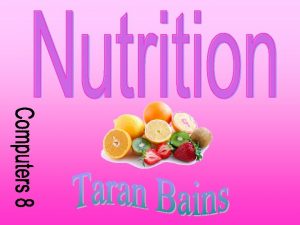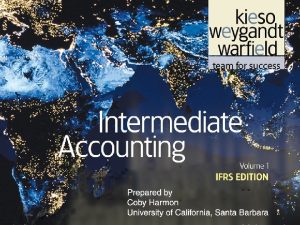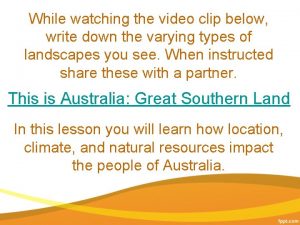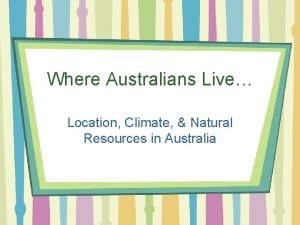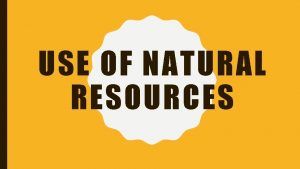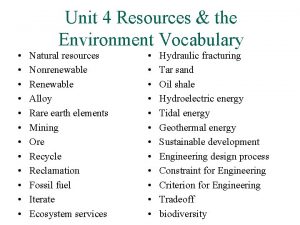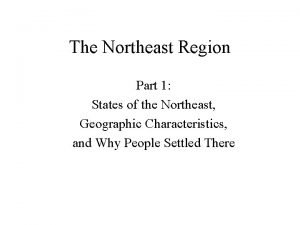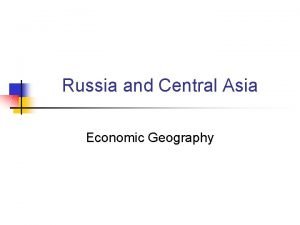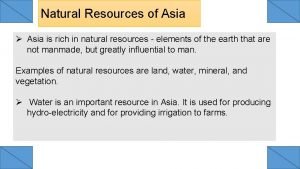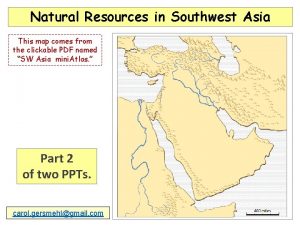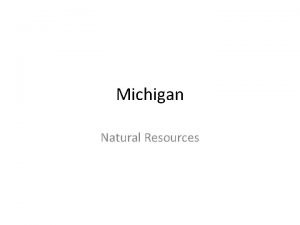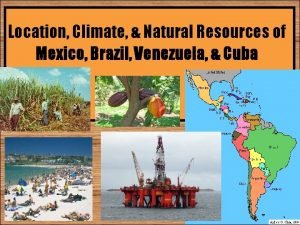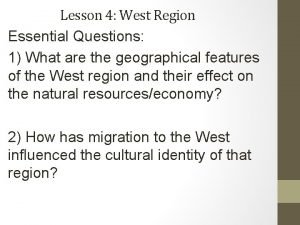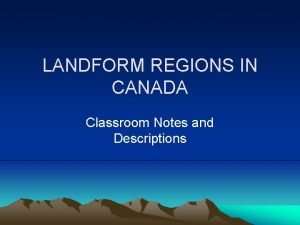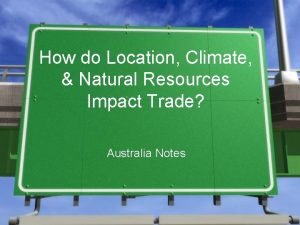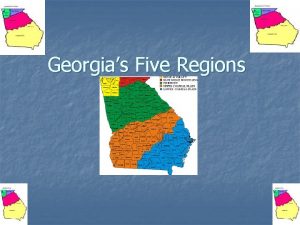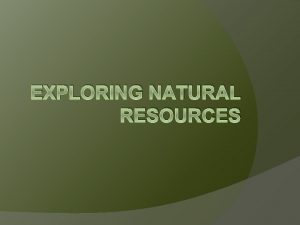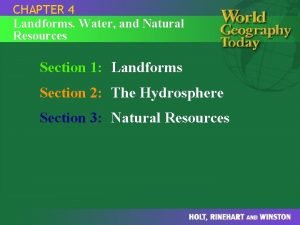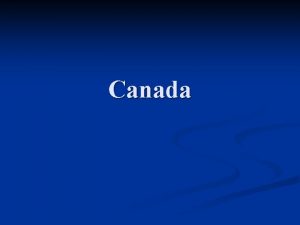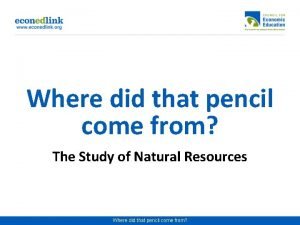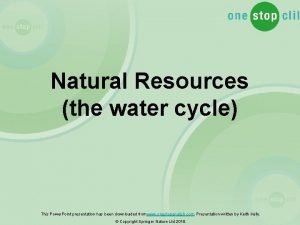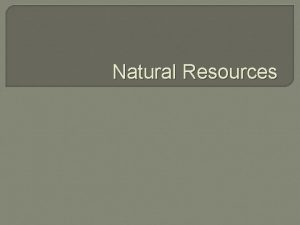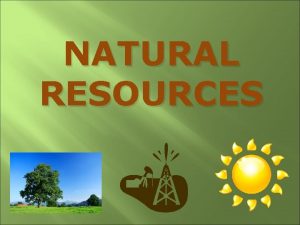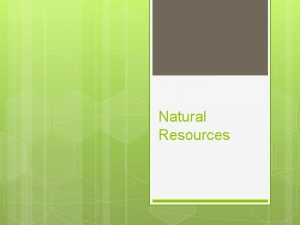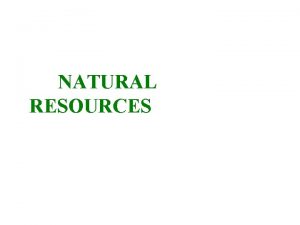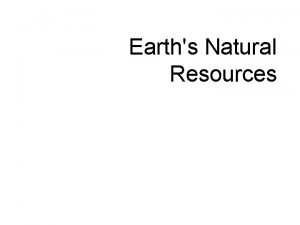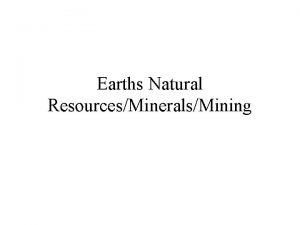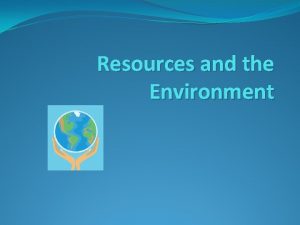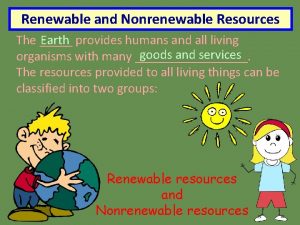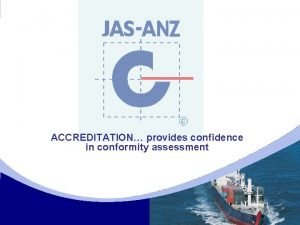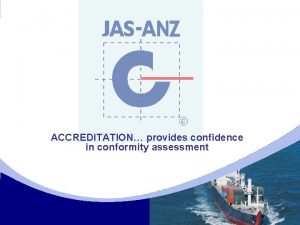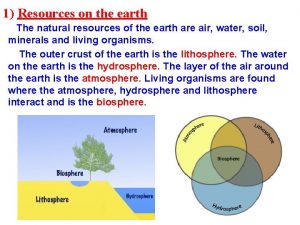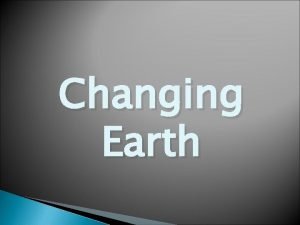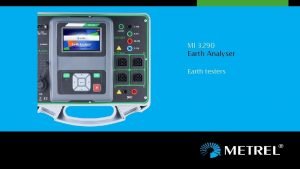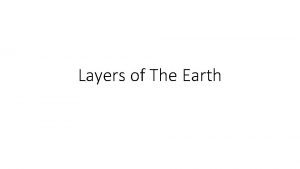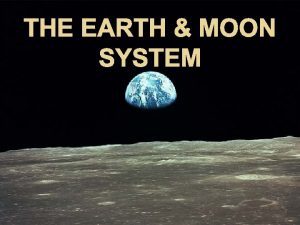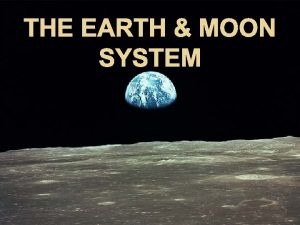Natural Resources Natural Resources resources that Earth provides

























































































- Slides: 89

Natural Resources

Natural Resources - resources that Earth provides. Ex. Air, water and land, all living things, rocks and minerals. Natural resources are changed through cycling. Renewable Resources - natural resources that it is possible to use indefinitely without causing a reduction in the available supply. Ex. Fresh air; fresh surface water in lakes, rivers and streams; nitrogen, carbon and phosphorous. Living organisms - reproduce. Sun - because it will last over 5 billion years, but not provided by earth.

Renewable Resource

Non. Renewable Resources Nonrenewable Resources - a resource that exists in a fixed amount in various places in earth’s crust and can be replaced only by geological, physical, and chemical processes that take hundreds of millions of years. Ex. Fossil fuels, copper, silver, and gold. Some areas are rich in other natural resources. Surinam and Guyana in South America are rich in bauxite. Saudi Arabia and Kuwait are rich in oil. The United States has the highest standard of living and it consumes 30% of earth’s mineral and energy resources each year, even though it has only 6% of the world’s population.

Gold/Bauxite/Silver

Energy




LOCATION OF OIL REFINERIES

Bed Rock Underneath the topsoil is a layer of soil consisting of inorganic matter including broken down rocks, sand, silt, clay and gravel. Slabs of Bedrock are cut from quarries and used in construction.

Aggregates - mixture of gravel, sand crushed stone. Used for a base for highways. Found in floodplains of river valleys. Other aggregates were deposited by glaciers. Aggregates are used to form concrete or mortar. Provides volume and stability to the mixture, and it also makes the finished surface more resistant to erosion and weathering. Ores - Natural resource

Aggregates

Ores - Natural resource that is mined as long as the value is greater than the cost. Hematite (Fe 2 O 3) is an iron ore because it contains 70% of the weight. · Settling of Crystals - ores associated with igneous rocks may contain iron, chromium, and platinum - form when minerals crystallize and settle to the bottom of a cooling body of magma. Ex. , One of the largest deposits of chromium and platinum in the world is the Bushveldt Complex in South America.

Copper ore

Land Resources The United States has 42% Certified as public land. Consists of forests, parks and wild- lifrefuges. 73% 22% Located in Alaska Western States National Park systems preserves scenic and unique natural landscapes. About 49% of the land in the national park systems is designated as wilderness.

Hydrothermal Fluids · Hydrothermal Fluids - source of metallic ore deposits. Hot water and other fluids may be part of the magma that is injected into surrounding rock during the last stages of magma crystallization. Copper and gold become concentrated in magma, solution fills veins, known as hydrothermal veins.

Chemical Precipitation · Chemical Precipitation - Ores of manganese and iron most commonly originate from chemical precipitation in layers. Iron ores are found in bands make up of alternating layer of iron-bearing minerals and chert.

Placer Deposits · Placer Deposits - Gold and Silver are heavy metals. The velocity and volume of water in a stream or river carries the grains of gold and silver. A decrease in volume and bends slows down and grains are deposited. Ex. Gold nuggets, gold dust, diamonds, and gemstones.

Placer deposit of GOLD

Concentration by Weathering Aluminum forms in bauxite through weathering in tropical climates. Other metals that become more concentrated as rocks weather include nickel, copper, silver, lead, tin, mercury, uranium, and manganese. ·

Soil The topsoil is the fertile part of soil. Land with not lot of vegetation will result in erosion and the loss of topsoil. Today, topsoil is eroding faster that it forms on about 1/3 of Earth’s croplands. Every 10 years, Earth loses about 7% of its topsoil. In arid and semi-arid areas of the world, loss of topsoil leads to desertification. Productive land becomes desert. Desertification is a growing problem in cattle-producing areas in North Africa south of the Sahara, Middle East, western half of the United States, and in Australia. Desertification is prevented by planting trees and shrubs to anchor soils and retain water.

Other Land Resources Clay - is a sediment, and a group of minerals, made up of tiny particles. Used in ceramics, china, tiles, and pottery. Salt - or sodium chloride, occurs in deposits on surface and underground. Ex. One of the most famous salt mines in the world is the Wieliczka Salt Mine in Poland. Other mineral resources found on the land are gypsum used for making plaster; talc used in cosmetics; and graphite which is used as a lubricant.


Salt Mine

Detroit Mi Salt Mines

Salt Mining

Detroit Salt Corridor

Using Land Resources Mining causes destruction to the contours of the land. Open pits leave waste rock and pollutants. Gangue is material left after the ore is extracted.

Open Pit Mining

Air Resources Oxygen make up 21% of the air. Water vapor can make up as much as 5% of air by volume.

Origins of Oxygen has not always been a part of Earth’s atmosphere. Ancient atmosphere was comprised of CO 2, N 2, and water vapor 4. 6 to 4. 5 billion years ago. As Earth cooled, rains washed most of the CO 2 out of the atmosphere and into the oceans. Early life forms used this CO 2 during photosynthesis and released oxygen.

Disrupting Earth’s Cycles Human activities are disrupting Earth’s delicate balance. Humans burn fossil fuels to produce electricity and burn forests to clear land. These activities release sulfur and nitrogen into the atmosphere. The sulfur is converted into SO 2 and H 2 SO 4 (sulfuric acid) which returns as ACID RAIN. Nitrogen oxides are converted into to NO 2 (nitric acid) which also returns as acid rain. Both the excess nitrogen oxides and sulfur are pollutants. Air pollution is when pollutants in the air occur in quantities that become harmful to human health and the health of the environment.

Largest air Pollution Source –U. S. The exhaust from motor vehicles - 90% of CO (carbon monoxide) pollution in cities. CO is a colorless, odorless gas which interferes with the body’s ability to absorb oxygen and causes headaches, chest pains, dry throat, and nausea.

Disrupting Earth’s cycles Human activities are disrupting Earth’s delicate balance. Human burn fossil fuels to produce electricity and burn forests to clear land. These activities release sulfur and nitrogen into the atmosphere. S+ H 20 ------ S 02 H 2 S 04 sulfuric acid returns as acid rain

Acid Rain

Acid Rain Forest

Nitrogen oxides are converted to HN 03 Air pollutants are substances that occur at levels that are harmful to humans and the environment.

NOx



Sources of Air Pollution Origins are both human and natural. Natural: volcanic eruptions, forest fires Human: gases, smoke, and dust. Largest source : Burning fossil fuels Single largest source in U. S. – motor vehicles 90% of CO carbon monoxide

CO It is a colorless, odorless gas that interferes with the body’s ability to absorb oxygen and causes headaches, chest pain, dry throat and nausea.

Sources Cont…. . Transport and Dilution. Pollution knows no boundaries Depends on wind direction and speed, topographical features and buildings interrupt the flow of winds and transport of the pollutants.


Source Cont… Transformation and Removal: Photochemical changes are triggered by UV Radiation. Photochemical smog- forms when a mixture of nitrogen oxides and volatile organic compounds interact under the influence of sunlight. Pollutants are removed by snow, mist, fog and rain.

Smog

Indoor Air Pollution Certain products offered in stores contain chemical to prevent damage to them. Indoor Pollutants Stylene Asbestos Tetrachloroethylene Carbon Monoxide Cholorform Formaldehyde Nitrogen Oxides Tobacco smoke

Indoor Pollution

Sick Building Lack proper air circulation Chemical odors are concentrated Symptoms: headaches, coughing sneezing, burning eyes , nausea, chronic fatigue and flu-like symptoms. Symptoms disappear when people leave the building.


Radon Gas Known radon is Radon 222 Colorless , odorless, and tasteless Produced by the decay of Uranium 238 Small amounts of U-238 found in soils and rocks. Radon found in these deposits seeps upwards through the soil into the atmopshere.


Radon

EPA Environmental Protection Agency They advise people to use a Radon test kit in their homes especially the older built ones.


Water Resources The ocean contains 97% of the planet water. 3% of the total water is freshwater 2. 97% is frozen in the polar ice caps 0. 003% available for human consumption

Importance of water 71% of the surface of the earth is covered with water Earth is the Water Planet Ocean regulates climate and provide habitat for marine organisms Organisms that live on Earth are made of mostly of water. 50% to 60% water by weight ex. trees 60% by weight

Properties of water Exist in three states of matter gas/liquid/solid Adhesive and Cohesive properties Boils at 100 C Freezes at 0 C High heat capacity Universal solvent Ice is less density than liquid water. It expands as it freezes.

Use of Freshwater Resources 70% Irrigation 18% croplands 80% of agricultural water used for irrigation evaporates or seeps into the ground, 23 % of freshwater is used for cooling, and production of oil and gas Of the that water drawn off 7% is Domestic and municipal use.

U. S. Water Usage


Dams and Reservoirs Manages water ways. Used to control flooding. Collect water for irrigation and municipal use Hydroelectric power Recreational activities Currently they controls between 25% and 50% of the total runoff on every continent.

China Largest Dam in The World: Three Gorges


Hoover DAM

Water releases from behind the dam

Ariel View Of the Colorado River/Hoover Dam

By Pass Road

Largest Reservoir Lake Meade

Hover Dam Story http: //vidi. Bv. P 1 QT 3 YAj 8 n 7 w 8 QF; _ylu=X 3 o. DMTBvc. X Nv. Nn. Bq. BHNl. Yw. Nzcg. Rzb. Gs. Ddmlk. BHZ 0 a. WQDVj. Ez Mw-? p=hoover+dam+story&vid=20 eb 98 b 91 c 84 a 0 fe 9 f 15 54 ea 6913 a 036&l=27%3 A 38&turl=http%3 A%2 F%2 Ft s 4. mm. bing. net%2 Fth%3 Fid%3 DV. 47831727732162 99%26 pid%3 D 15. 1&rurl=http%3 A%2 F%2 Fwww. yout ube. com%2 Fwatch%3 Fv%3 Dn 4 o 8 NISa 4 Hs&tit=The +story+of+Hoover+Dam&c=0&sigr=11 ajnr 9 vj&fr=yfpt-701&tt=b


Aqueducts Romans built the first to transport water. Today there are tunnels, aqueducts and underground pipes/

Roman Aqueducts

California Water Project A series of aqueducts that carry water for Northern California to Southern California.



Tapping Ground Water 23% of all freshwater is pumped from aquifers. ex. Florida, Hawaii, Nebraska – Here 90% of the population depend on ground water from aquifers for drinking water. Most produce hard water.

AQUIFER

Largest Aquifer OGALLALA

Hard Water contain a high level of Calcium and magnesium ions and does not form suds when soap is added Ground water moves from points for high elevation and pressure to points of lower elevation and pressure. Moves at a rate of 1 m/yr.

Hard water/ Aquifers If the withdrawn rate of an aquifer exceeds its natural recharge, the water table around the withdrawn point is lowered and is known as draw down. If too many wells are drawn down too lower than the well will go dry.


SOFT WATER


Desalination Removal of salt from water. Desalination – Occurs when salt water is distilledusing a process of evaporation wheh is very expensive. Most countries use solar energy to evaporate sea water.


Reducing Freshwater Use Trickle irrigation Provides water directly to the plants roots Industry uses recycle water Installed low flow toilets Using drought resistant plants Fixing leaking pipes

Trickle Irrigation
 Phân độ lown
Phân độ lown Block nhĩ thất độ 3
Block nhĩ thất độ 3 Thơ thất ngôn tứ tuyệt đường luật
Thơ thất ngôn tứ tuyệt đường luật Thơ thất ngôn tứ tuyệt đường luật
Thơ thất ngôn tứ tuyệt đường luật Chiến lược kinh doanh quốc tế của walmart
Chiến lược kinh doanh quốc tế của walmart Tìm độ lớn thật của tam giác abc
Tìm độ lớn thật của tam giác abc Con hãy đưa tay khi thấy người vấp ngã
Con hãy đưa tay khi thấy người vấp ngã Tôn thất thuyết là ai
Tôn thất thuyết là ai Gây tê cơ vuông thắt lưng
Gây tê cơ vuông thắt lưng Sau thất bại ở hồ điển triệt
Sau thất bại ở hồ điển triệt The earth provides
The earth provides Chapter 27 human impact on earth resources
Chapter 27 human impact on earth resources Earth resources examples
Earth resources examples How do people destroy natural resources
How do people destroy natural resources Earth resources examples
Earth resources examples Earth resources kitty hawk
Earth resources kitty hawk Name of natural satellite
Name of natural satellite Natural source of water on earth
Natural source of water on earth Elevation definition ap human geography
Elevation definition ap human geography Difference between transforming and transformed resources
Difference between transforming and transformed resources Fixed and variable resources
Fixed and variable resources Renewable vs nonrenewable resources worksheet
Renewable vs nonrenewable resources worksheet Provides a graphical representation of an electric field
Provides a graphical representation of an electric field Figure 12-1 provides an overview of the lymphatic vessels
Figure 12-1 provides an overview of the lymphatic vessels Mutual supplementation of protein
Mutual supplementation of protein Scope of management accounting
Scope of management accounting Law enforcement agencies data system
Law enforcement agencies data system Nitro group on ir
Nitro group on ir Embryology provides evidence for evolution because
Embryology provides evidence for evolution because Electrical potential energy
Electrical potential energy If a battery provides a high voltage, it can ____.
If a battery provides a high voltage, it can ____. Vt=2pir/t
Vt=2pir/t Provides bulk and structure to baked products.
Provides bulk and structure to baked products. Cellular digital packet data
Cellular digital packet data The coriolis effect provides evidence that
The coriolis effect provides evidence that If you whirl a tin can on the end of a string
If you whirl a tin can on the end of a string It provides structural support for the entire body
It provides structural support for the entire body What is x.800 security service
What is x.800 security service Workers rights practice worksheet crossword puzzle answers
Workers rights practice worksheet crossword puzzle answers Hadoop hive architecture
Hadoop hive architecture An appositive provides more information about a noun.
An appositive provides more information about a noun. Jdk provides an interpretive compiler for java.
Jdk provides an interpretive compiler for java. This list provides examples of —
This list provides examples of — Stabilization against variations in vbe and beta
Stabilization against variations in vbe and beta It provides a common framework to allow data to be shared
It provides a common framework to allow data to be shared Uses rigid metallic platters
Uses rigid metallic platters Ir spectroscopy provides information about
Ir spectroscopy provides information about A drag lens provides
A drag lens provides Modern auto tech
Modern auto tech Operating system is an interface between
Operating system is an interface between Who is the thane of glamis
Who is the thane of glamis Semaphore provide a primitive yet powerful and flexible
Semaphore provide a primitive yet powerful and flexible Message authentication code example
Message authentication code example Food provides energy
Food provides energy Most generic, unqualified state of feeling good.
Most generic, unqualified state of feeling good. Provides uniform interface between controller and kernel
Provides uniform interface between controller and kernel Flaws john provides map equipment
Flaws john provides map equipment This discovery provides evidence of
This discovery provides evidence of Provides general information
Provides general information Food chain for class 6
Food chain for class 6 Dna v rna venn diagram
Dna v rna venn diagram Each database system supporting odbc provides
Each database system supporting odbc provides Each database system supporting odbc provides a/an
Each database system supporting odbc provides a/an Provides the body with energy. *
Provides the body with energy. * Aaawwa
Aaawwa When to record contingent liabilities
When to record contingent liabilities Australia major natural resources
Australia major natural resources Climate of australia
Climate of australia What are the 4 types of natural resources
What are the 4 types of natural resources Natural resources vocabulary
Natural resources vocabulary Natural resources northeast region
Natural resources northeast region What are russia natural resources
What are russia natural resources Malaysia rich in natural resources
Malaysia rich in natural resources Natural resources in southwest asia
Natural resources in southwest asia What is michigan's natural resources
What is michigan's natural resources What are cuba's natural resources
What are cuba's natural resources Natural resources in west region
Natural resources in west region What are the physical features of the hudson bay lowlands
What are the physical features of the hudson bay lowlands Australia natural resources
Australia natural resources The climate in the coastal plains region
The climate in the coastal plains region Explain natural resources
Explain natural resources Japan major natural resources
Japan major natural resources Japan natural resources
Japan natural resources Japan natural resources
Japan natural resources Chapter 4 landforms water and natural resources
Chapter 4 landforms water and natural resources Landforms and natural resources
Landforms and natural resources Plant assets are
Plant assets are Natural resources to make a pencil
Natural resources to make a pencil Balcones escarpment
Balcones escarpment Natural resources water cycle
Natural resources water cycle













